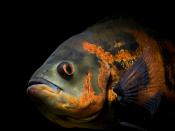'The Fish' by Elizabeth Bishop is saturated with vivid imagery and abundant description, which help the reader visualize the action. Bishop's use of imagery, narration, and tone allow the reader to visualize the fish and create a bond with him, a bond in which the reader has a great deal of admiration for the fish's plight. The mental pictures created are, in fact, so brilliant that the reader believes incident actually happened to a real person, thus building respect from the reader to the fish.
Initially the reader is bombarded with an intense image of the fish; he is 'tremendous,' 'battered,' 'venerable,' and 'homely.' The reader is sympathetic with the fish's situation, and can relate because everyone has been fishing. Next, Bishop compares the fish to familiar household objects: 'here and there / his brown skin hung in strips / like ancient wallpaper, / and its pattern of darker brown / was like wallpaper;' she uses two similes with common objects to create sympathy for the captive.
Bishop then goes on to clearly illustrate what she means by 'wallpaper': 'shapes like full-blown roses / stained and lost through age.' She uses another simile here paired with descriptive phrases, and these effectively depict a personal image of the fish. She uses the familiar 'wallpaper' comparison because it is something the readers can relate to their own lives. Also the 'ancient wallpaper' analogy can refer to the fish's age. Although faded and aged he withstood the test of time, like the wallpaper. Bishop uses highly descriptive words like 'speckled' and 'infested' to create an even clearer mental picture. The word 'terrible' is used to describe oxygen, and this is ironic because oxygen is usually beneficial, but in the case of the fish it is detrimental. The use of 'terrible' allows the reader...


